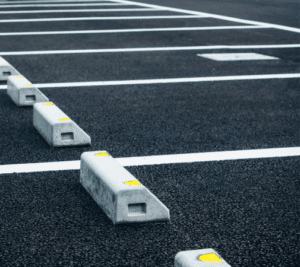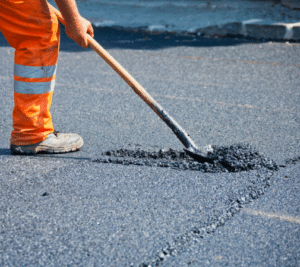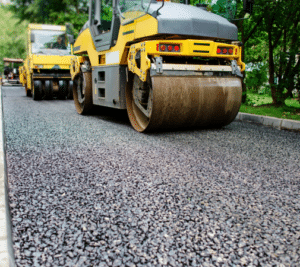Are you planning to install a new driveway or parking lot, or perhaps you’re looking to refresh your existing asphalt surface? If so, you may have heard the terms “sealcoating” and “asphalt paving” used interchangeably.
However, while both processes involve the application of a coating to asphalt surfaces, there are some critical differences between them. In this blog post, we’ll what both of these processes are, and when they should be utilized.
We’ll also explore the similarities and differences between the two and give the pros and cons of each.
What is Paving?
Paving refers to the installation or resurfacing of an asphalt surface and can involve different methods depending on the project’s specific needs.
For example, overlays involve the placement of a layer of asphalt over an existing surface, while resurfacing may include removing the existing surface layer before applying a new layer of asphalt.
What is Sealcoating?
On the other hand, this is a process in which a protective coating is applied to an existing asphalt surface to help prolong its lifespan and prevent damage from factors such as weather, traffic, and oxidation.
This process involves the application of a specialized sealant material that fills in small cracks and pores in the asphalt, creating a smooth and uniform surface that is resistant to water and other types of damage.
What are the Different Types of Sealcoating?
Several different types of sealcoating materials are available, each with unique benefits and properties. One common type is acrylic polymer sealer, made from a combination of acrylic polymers and other materials to create a durable and long-lasting surface.
Another type is asphalt sealer, made from a blend of asphalt emulsion, water, and other materials to provide a protective layer resistant to UV rays and other forms of damage.
Finally, coal tar sealer is another common type of sealcoating material made from a mixture of coal tar, water, and other materials to create a protective layer resistant to moisture and other types of damage.
Paving vs Sealcoating: What are the Similarities?
While paving and sealcoating are two different processes, they have some similarities. For example, both can be used to improve the appearance and functionality of an asphalt surface, and both can help prolong the surface’s lifespan.
Additionally, both processes require proper preparation and application techniques to ensure the coating is applied evenly and effectively.
Paving vs Sealcoating: What’s the Difference?
However, there are also some critical differences between the two processes. Paving involves installing or resurfacing an asphalt surface, while sealcoating involves the application of a protective coating to an existing surface.
Additionally, while paving can repair significant damage or deterioration in an asphalt surface, sealcoating is primarily used as a preventative measure to help prevent damage from occurring in the first place.
What are the Pros and Cons of Paving vs Sealcoating?
When considering the pros and cons of these two processes, it’s important to keep in mind the specific needs and goals of the project. Paving can be more expensive than sealcoating, but it may be necessary for significantly damaged or deteriorated surfaces.
Additionally, paving can provide a more long-term solution, as it involves the installation of a completely new asphalt surface.
Sealcoating, on the other hand, is a more cost-effective option that can help to prolong the lifespan of an existing asphalt surface. While it may not be able to repair significant damage or deterioration, it can provide a layer of protection that helps to prevent damage from occurring in the first place.
However, it’s important to note that sealcoating should only be done on surfaces in good condition, as applying a sealant to a surface that is already significantly damaged or deteriorated may make the problem worse.
What are the Best Uses of Sealcoating
Regarding the best uses of sealcoating, there are two main applications to consider. First, sealing newly paved asphalt can help to protect the surface from damage and prolong its lifespan. This is especially important for high-traffic areas such as parking lots and driveways, where the surface will likely experience significant wear and tear.
Second, it can be a preventative measure to prevent wear and damage to an existing asphalt surface. This can be especially beneficial in areas with harsh weather conditions, such as areas with frequent freeze-thaw cycles or areas with high levels of UV exposure.
What are the Best Uses of Paving?
As for the best uses of paving, there are two main applications to consider. First, it can repair significant deterioration or damage to an asphalt surface. This may involve removing the existing surface layer and replacing it with a new asphalt layer or installing a completely new asphalt surface. Second, it can be used to install new asphalt surfaces, such as in constructing a new parking lot or driveway.
In summary, while paving and sealcoating may sound similar, they are two distinct processes with unique purposes and benefits.
Paving involves installing or resurfacing an asphalt surface, while sealcoating involves the application of a protective coating to an existing surface.
When deciding which option is best for a specific project, it’s important to consider factors such as the condition of the existing surface, the level of damage or deterioration, and the particular goals and needs of the project.
By understanding the differences between paving and sealcoating and working with a qualified and experienced contractor, it’s possible to create a durable and long-lasting asphalt surface that will provide years of reliable service.
Asphalt Paving and Sealcoating Services in Arizona
Are you needing asphalt services but help determine whether you need sealcoating or paving? Saguaro Asphalt, based in Phoenix, Arizona, offers a range of asphalt services, including sealcoating, paving, and resurfacing. Our team of experts can help you determine which option is best for your project!
Give us a call today.



